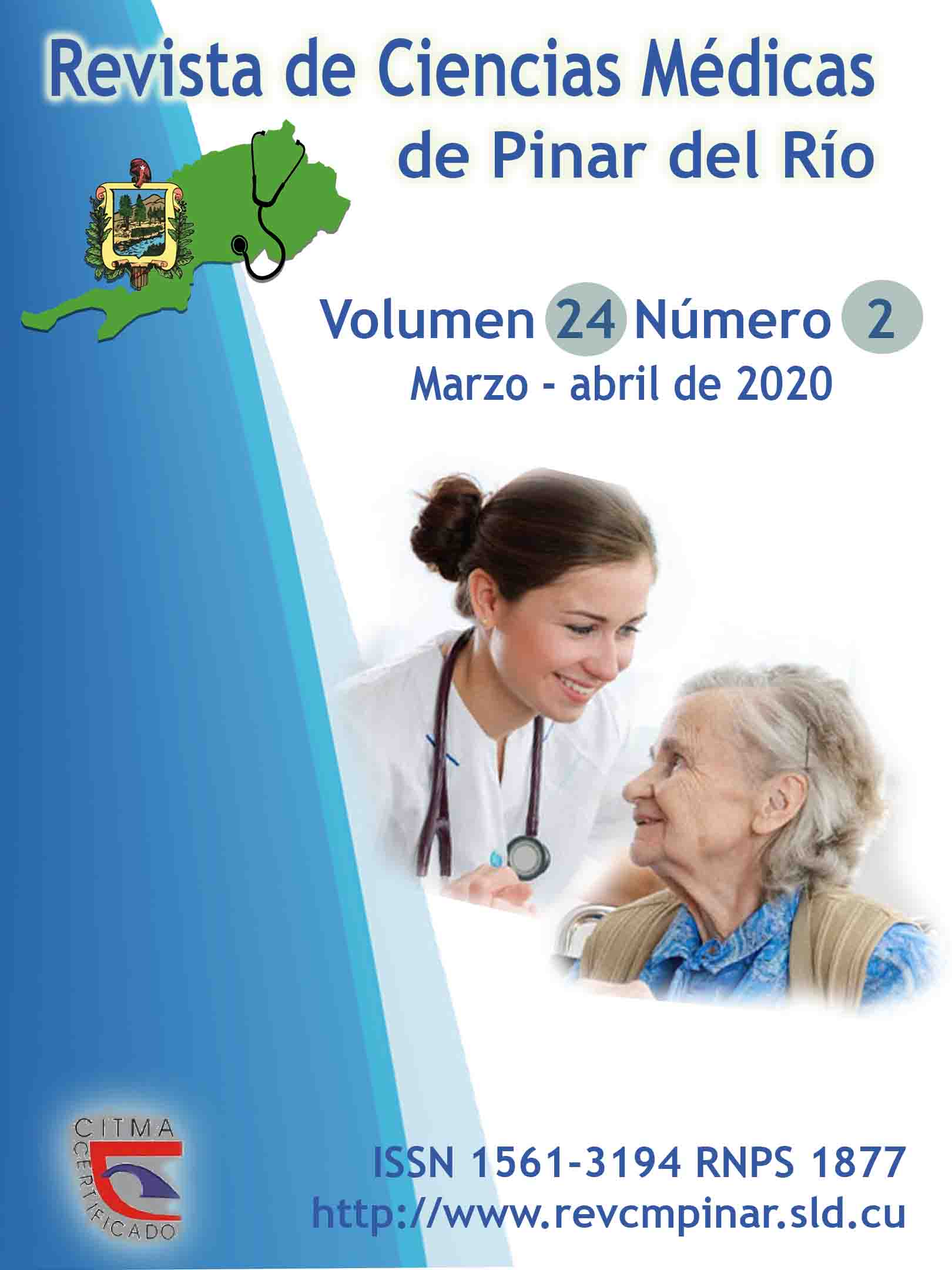Factores de riesgo del síndrome metabólico en adolescentes de San Juan y Martínez
Palabras clave:
SÍNDROME METABÓLICO, ENFERMEDADES METABÓLICAS, ENFERMEDADES NUTRICIONALES Y METABÓLICAS, ADOLESCENTE, OBESIDAD, OBESIDAD ABDOMINAL.Resumen
Introducción: el síndrome metabólico se caracteriza por la obesidad central, anomalías metabólicas, dislipidemia e hipertensión arterial y comprende diferentes alteraciones cardiovasculares; así como la presencia de diabetes mellitus.
Objetivo: caracterizar los factores de riesgo del síndrome metabólico en adolescentes de San Juan y Martínez durante el año 2018.
Métodos: se realizó un estudio observacional, descriptivo y transversal. El universo estuvo constituido por 522 pacientes, se seleccionaron 141 adolescentes mediante un muestreo aleatorio simple. Se realizó la revisión de las historias de salud individual y familiar. Los datos obtenidos fueron procesados mediante SPSS.
Resultados: existió predominio del sexo femenino (58,87 %) y color de piel blanca (80,14 %). El 63,1 % presentó antecedentes de hipertensión arterial en familiares de primera línea y el 61 % mostró hábitos alimentarios regulares. El 54,6 % de la muestra se encontró normopeso, el 75,2 % refirió ingerir bebidas alcohólicas y el 88 % eran fumadores.
Conclusiones: la presencia de factores de riesgo del síndrome metabólico es cada día mayor en los adolescentes, lo cual trae grandes probabilidades para desarrollarlo en esta etapa de la vida. El diagnóstico precoz permite trabajar sobre ellos y evitar futuras enfermedades y complicaciones asociadas.
Descargas
Citas
1. Zimmet P, Alberti KG, Kaufman F, Tajima N, Silink M, Arslanian S, et al. The metabolic syndrome in children and adolescents-an IDF consensus report. Pediatric Diabetes [Internet]. 2007 Oct [citado 25/04/2019]; 8(5): [aprox. 7p.]. Disponible en: https://onlinelibrary.wiley.com/doi/abs/10.1111/j.1399-5448.2007.00271.x
2. Araujo Herrera O. Síndrome metabólico en la infancia: un enfoque para la atención primaria. Rev Cubana Pediatr [Internet]. 2015 Ene- Mar [citado 24/04/2019]; 87(1): [aprox. 9p.]. Disponible en: http://scielo.sld.cu/scielo.php?script=sci_arttext&pid=S0034-75312015000100010
3. Ortega FB, Lavie CJ, Blait SN. Obesity and cardiovascular disease. Circulation Research [Internet]. 2016 [citado 16/04/2019]; 118(11): [aprox. 18p.]. Disponible en: https://www.ahajournals.org/doi/full/10.1161/CIRCRESAHA.115.306883
4. Arrunátegui Correa V. Despistaje de Diabetes Mellitus tipo 2 en una población adulta urbana del distrito de Coishco, Ancash, Perú. Rev Med Hered [Internet]. 2015 Jul [citado 16/04/2019]; 26(3): [aprox. 3p.]. Disponible en: http://www.scielo.org.pe/scielo.php?script=sci_arttext&pid=S1018-130X2015000300006
5. Bernardi JR, Gesaro CD, Fisberg RM, Fisberg M. Estimation of energy and macronutrient intake at home and in the kindergarten programs in preschool children. Rev J Pediatr [Internet]. 2010 Feb [citado 16/04/2019]; 86(1): [aprox. 5 p.]. Disponible en: http://www.scielo.br/scielo.php?script=sci_arttext&pid=S0021-75572010000100011&lng=en&nrm=iso&tlng=en
6. Rodríguez M, Puchulu F. Conocimientos y actitudes hacia la Diabetes Mellitus en la Argentina. MEDICINA (Buenos Aires) [Internet] 2015 [citado 16/04/2019]; 75(6): [aprox. 13p.]. Disponible en: https://medicinabuenosaires.com/revistas/vol75-15/n6/353-366-Med6351-Rodriguez.pdf
7. MINSAP. Anuario estadístico de salud 2017 [Internet]. La Habana: Dirección Nacional de Registros Médicos y Estadísticas de Salud; 2017 [citado 16/04/2019]: [aprox. 193 p.]. Disponible en: http://files.sld.cu/dne/files/2018/04/Anuario-Electronico-Espa%C3%B1ol-2017-ed-2018.pdf
8. González Sánchez R, Llapur Milián R, Díaz Cuesta M, Illa Cos MR, Yee López E, Pérez Bello D. Estilos de vida, hipertensión arterial y obesidad en adolescentes. Rev Cubana Pediatr [Internet]. 2015 [citado 16/04/2019]; 87(3): [aprox. 11 p.]. Disponible en: http://scielo.sld.cu/scielo.php?script=sci_arttext&pid=S0034-75312015000300003
9. Burrows R, Atalah E, Leiva L, Rojas P, De la Maza MP, Vásquez F, et al. Prevalencia del síndrome metabólico en niños y adolescentes chilenos con historia familiar de enfermedades crónicas no transmisibles. ALAN [Internet]. 2012 Jun [citado 16/04/2019]; 62(2): [aprox. 4p.]. Disponible en: https://www.alanrevista.org/ediciones/2012/2/art-8
10. Gorrita Pérez RR, Ruiz King Y, Hernández Martínez Y, Sánchez Lastre M. Factores de riesgo de enfermedades cardiovasculares y cerebrovasculares en adolescentes. Rev Cubana Pediatr [Internet]. 2015 [citado 16/04/2019]; 87(2): [aprox. 15p.]. Disponible en: http://scielo.sld.cu/scielo.php?script=sci_arttext&pid=S0034-75312015000200002
11. Pampillo Castiñeiras T, Arteche Díaz N, Méndez Suárez MA. Hábitos alimentarios, obesidad y sobrepeso en adolescentes de un centro escolar mixto. Rev Ciencias Médicas. [Internet]. 2019 [citado 16/04/2019]; 23(1): [aprox. 15p.]. Disponible en: http://scielo.sld.cu/scielo.php?script=sci_arttext&pid=S1561-31942019000100099
12. Hanson M, Gluckman P, Bustreo F. Obesity and the health of future generations. Lancet Diabetes Endocrinol [Internet]. 2016 [citado 16/01/2019]; 4(12): [aprox. 5p.]. Disponible en: https://www.ncbi.nlm.nih.gov/pubmed/27743979
13. Borrás Santiesteban T. Metodología para la atención a la adolescencia temprana con consumo etílico o vulnerable a esta conducta. CCM [Internet]. 2016 [citado 16/04/2019]; 20(4): [aprox. 15p.]. Disponible en: http://scielo.sld.cu/scielo.php?script=sci_abstract&pid=S1560-43812016000400014&lng=es&nrm=iso
14. Araujo Herrera O. Síndrome metabólico en la infancia: un enfoque para la atención primaria. Rev Cubana Pediatr [Internet]. 2015 [citado 16/04/2019]; 87(1): [aprox. 9p.]. Disponible en: http://scielo.sld.cu/scielo.php?script=sci_arttext&pid=S0034-75312015000100010
15. Lazo Herrera LA, Linares Cánova LP, Vitón Castillo AA, Díaz Pita G. Nivel de conocimiento sobre alcoholismo en adolescentes de un consultorio médico. 16 de abril [Internet]. 2019 [citado 15/10/2019]; 58(271): [aprox. 4p.]. Disponible en: http://www.rev16deabril.sld.cu/index.php/16_04/article/view/659/
Publicado
Cómo citar
Número
Sección
Licencia
Aquellos autores/as que tengan publicaciones con esta revista, aceptan los términos siguientes:- Los autores/as conservarán sus derechos de autor y garantizarán a la revista el derecho de primera publicación de su obra, el cuál estará simultáneamente sujeto a la Licencia de reconocimiento de Creative Commons que permite a terceros compartir la obra siempre que se indique su autor y su primera publicación esta revista.
- Los autores/as podrán adoptar otros acuerdos de licencia no exclusiva de distribución de la versión de la obra publicada (p. ej.: depositarla en un archivo telemático institucional o publicarla en un volumen monográfico) siempre que se indique la publicación inicial en esta revista.
- Se permite y recomienda a los autores/as difundir su obra a través de Internet (p. ej.: en archivos telemáticos institucionales o en su página web) antes y durante el proceso de envío, lo cual puede producir intercambios interesantes y aumentar las citas de la obra publicada. (Véase El efecto del acceso abierto).



